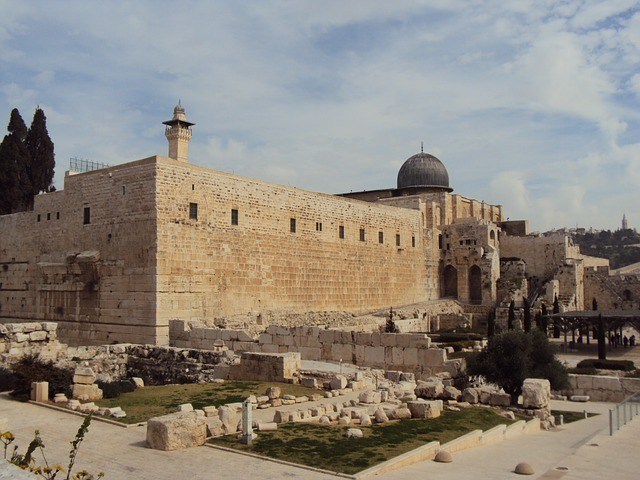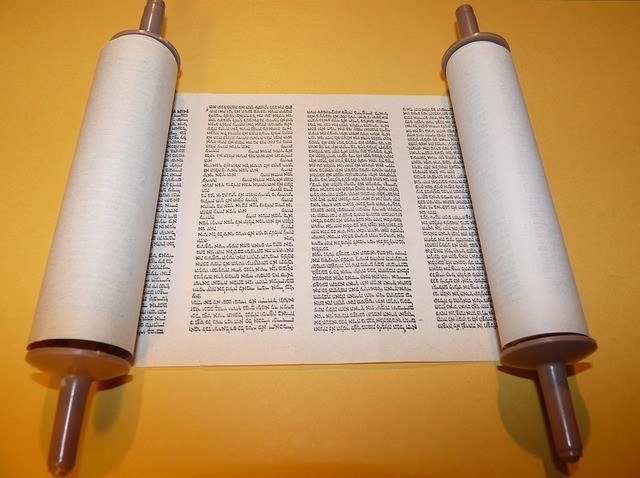
Each day, across all walks of life, the Word is received for the first time. Its complex text may make one question how to begin studying the Bible. The Holy Bible is the most widely read and distributed text in circulation and has fundamentally shaped the course of Western civilization.
Embarking on a spiritual journey requires serious consideration and reflection. Deciding where to start one’s spiritual education can also be challenging when contemplating how to begin studying the Bible. Consider a biblical language or biblical study course as the first step toward understanding and decoding the original meaning of biblical texts, as originally written. Later in this article you can read more about such courses.
Parallel Lines: Biblical Hebrew and the Hebrew Bible
The key to a more meaningful and spiritual relationship with the Hebrew Bible starts with developing a deeper understanding of its ancient texts, in its ancient language as written. The most advantageous reason to consider studying biblical languages is to have the ability to possess the original message of the Bible, as opposed to subsequent opinions through various translations.
Known as the sacred text of Judaism, in its most simple distillation, the Hebrew Bible weaves the definitive account of God’s monotheistic relationship with the people of Israel and the trials and tribulations they faced as God’s chosen ones.
The Hebrew Bible begins with God’s creation of Earth and humankind. The first collection of books (known as the Torah) detail God’s promise to Abraham that he would be the antecedent of a great nation, as well as the ordeals his descendants (from Isaac to Moses) faced, and their eventual settlement of the Promised Land.
Succeeding collections (known as the Nevi’im) illustrate the continuation of the Israelites in the Promised Land. From the abandonment of their faith and dire warnings in the face of divine punishment from the prophets to the eventual establishment of a monarchal society to restore their breaking of the covenant.
In its final collections (known as the Ketuvim), the Hebrew Bible offers teachings on the history of the Jewish people, selected poetry, and lessons on theology.
The Hebrew Bible may also be referred to as the Mikra or the Tanakh. Tanakh is an acronym representing Torah, Nevi’im, and Ketuvim. The Torah refers to this acronym as “teaching,” while Nevi’im represents “prophets,” and Ketuvim denotes “writings.”
In the texts that make up the Tanakh, each represents important spiritual philosophies that are fundamental to the Hebrew Bible.
The Torah contains the principles derived from the books of Genesis, Exodus, Leviticus, Numbers, and Deuteronomy. It serves as the principal narrative of the Jewish people and begins with the chronicle of Abraham and his immediate decedents who represent the first monotheists and primary ancestors of the Promised Land. The Torah then turns to the plight of the Hebrew slaves in Egypt, their Exodus, and Moses’ receiving of the Torah atop Mount Sinai.

In teachings and practices of Rabbinic Judaism, the transmission of the Torah to Moses occurred in two parts, with the written Torah comprised of Genesis through Deuteronomy and the oral Torah, which was imparted upon the successors of Moses. The Torah ends with Moses’ death and the climax of the “Children of Israel” entering the Promised Land (referred to in the Torah as “Canaan”).
In the Nevi’im, the teachings of the Prophets are chronicled through anecdotes of notable figures in Jewish history. The Nevi’im is divided into the historical works of the “Earlier Prophets” (including Joshua and Samuel) and the “Later Prophets” (including Isaiah, Jeremiah, and Ezekiel). In the third and final books of the Tanakh, the Ketuvim is comprised of poetry, theology, and dramatic works, including Psalms, Proverbs, and Job.
Biblical Hebrew, also known as classical Hebrew, is believed to have been spoken between the 10th century BCE up until the 5th century CE. Archeological evidence found at Khirbet Qeiyafa (an ancient fortress city overlooking the Elah Valley, what is now modern-day Israel) traces its origins back even further to between 2350 BCE to 1200 BCE. Around 200 CE, Biblical Hebrew developed into a primarily liturgical and literary language. Today, the Hebrew Bible remains the primary source of Biblical Hebrew. After a resurgence from Medieval Hebrew in the 19th century, Biblical Hebrew is currently taught in public schools throughout Israel.
In a 2016 article about the development of Biblical Hebrew, Professor Avi Hurvitz argues the existence of three forms of Biblical Hebrew and that each corresponded to texts in the Hebrew Bible.
According to Professor Hurvitz, the first (known as Archaic Biblical Hebrew) is recorded in fragments of the Pentateuch, parts of what is called the “Early Prophets,” as well as the Book of Psalms. The second, known as Standard/Classical Biblical Hebrew, can also be found in the Pentateuch, the “Early Prophets,” as well as in “Later Prophets” (like Hosea, Amos, and Micha). The third and final form is known as Late Biblical Hebrew, which is documented in the Ketuvim.
Archaeological Timeline of the Hebrew Bible

Scholars differ as to when the Hebrew Bible was settled, with some arguing sometime between 140 BCE and 37 BCE (during the period of the Hasmonean Dynasty), and others who claim it was fixed after 100 CE. PBS’ NOVA documented in 2005 the discovery of a prototypical version of the Hebrew alphabet at the Tel Zayit archaeological site in Israel, dating back to the 10th century BCE.
According to biblical scholar William Schniedewind, Chair of Ancient Eastern Mediterranean Studies at the University of California (Los Angeles), while the invention of the alphabet itself dates back to 2000 BCE, its use was primarily limited to ruling classes. However, by the eighth century BCE (and the subsequent rise of the Assyrian Empire), urbanization of society and a changing sociopolitical climate encouraged the expansion of the written word throughout the Holy Land. This led ancient Judeans to collect the traditions and laws of their predecessors and transform them into literary manuscripts.
What is widely known is that, according to the Talmud (the principal text of Rabbinic Judaism and primary source for Jewish religious law), much of the Hebrew Bible was compiled in 450 BCE and remains unchanged to this day. Subsequent archaeological evidence also finds that after the fall of the Babylonian Empire in the sixth century BCE, the crux of the Hebrew Bible had already been completed.
How to Begin Studying the Bible and Start Your Spiritual Journey
 In partnership with the Hebrew University of Jerusalem, one of the world’s foremost research centers for biblical studies, the Israel Institute of Biblical Studies engages students in the immersive world of the Holy Bible. With a wide range of courses available, led by leading biblical scholars and experts, the Holy Bible’s text comes alive through its history, land, culture, language, and people. Classes are accessible virtually, anywhere, and anytime so students can learn at their own pace (and, even in their own language). Along with its prestigious reputation as a renowned academy, all classical language courses are accredited and recognized by colleges and universities throughout the world.
In partnership with the Hebrew University of Jerusalem, one of the world’s foremost research centers for biblical studies, the Israel Institute of Biblical Studies engages students in the immersive world of the Holy Bible. With a wide range of courses available, led by leading biblical scholars and experts, the Holy Bible’s text comes alive through its history, land, culture, language, and people. Classes are accessible virtually, anywhere, and anytime so students can learn at their own pace (and, even in their own language). Along with its prestigious reputation as a renowned academy, all classical language courses are accredited and recognized by colleges and universities throughout the world.
Knowing the Linguistic Origins of the Holy Bible
Reading the Holy Bible, as originally written, can be a transformative experience. The Biblical Hebrew courses offered at the Israel Institute of Biblical Studies allow students the opportunity to master the Hebrew alphabet and biblical composition in order to gain a more philosophical understanding of its ancient texts. Starting with the “Beginner” course, students embark on a journey to learning the mysteries of the Hebrew Bible.
From there, four additional courses are available. In Biblical Hebrew’s “Improved” and “Intermediate” curriculum, students analyze the Hebrew Bible in its original languages and learn its meaning independently. The “Advanced’ and “Expert” courses delve further into biblical literature through teachings on the Dead Sea Scrolls, the Books of Psalms, Proverbs, and more.
Approaching one of the first languages occurring in the Holy Bible, the Biblical Aramaic course offered at the Israel Institute of Biblical Studies unlocks the hidden meanings of the Hebrew Bible. Meanings, which were lost over time to subsequent translations. Featured in the Books of Daniel and Ezra, Biblical Aramaic became the language of culture and learning by the Jewish people around the sixth century BCE but was gradually reduced to a liturgical and theological language after the emergence of Modern Aramaic in the third century CE.
The Biblical Aramaic course at the Israel Institute of Biblical Studies is available for students to enrich and complete their complete understanding of and appreciation for ancient texts and Holy Scriptures.
The Language of Biblical Translations
While Biblical Hebrew and Biblical Aramaic are known as the principal written languages of the Hebrew Bible, most early translations were written in Biblical Greek, which was based on the language spoken by the Greeks of Athens between the reign of Alexander the Great and through the early Byzantine Empire (roughly from 300 BCE – 300 CE).
Biblical Greek can also refer to Koine Greek and is also the language of the Christian New Testament and a third century BCE translation of the Hebrew Bible. The Greek Orthodox Church continues to use Biblical Greek as the language spoken in liturgical services.
The Israel Institute of Biblical Studies offers a two-level “Beginner” and “Improved” Biblical Greek course. Through learning Biblical Greek letters and syntax, students discover how those translations have altered the fundamental meaning of the New Testament throughout the course of history.
Leading Experts. Scholarly Excellence
The courses available at the Israel Institute of Biblical Studies were designed with the success of the student in mind, by the world’s foremost scholars and professionals. That is at the heart of the quality and success of the carefully curated courses available. All of the teachers at the Institute possess a passion for biblical studies and languages and create a supportive and richly rewarding educational environment.

As Academic Program Developer for Biblical Hebrew, Dr. Ohad Cohen’s distinguished expertise in classical languages, including Biblical Hebrew and Aramaic, has led to numerous awards, prizes, and grants, along with recognition for his educational excellence. Dr. Cohen’s teachings have propelled the arc of the Classical Hebrew course at the Israel Institute of Biblical Studies.
With an M.A. degree in Classical Philology received from the prestigious Harvard University, Judith Green serves as Academic Developer for Biblical Greek at the Israel Institute of Biblical Studies. A scholar mastering Greek language, art, and archaeology, Ms. Green is also a leading classical archaeologist, as well as a graduate studies lecturer of Classical Greek at the Hebrew University of Jerusalem.
Both a scholar in Early and Modern Church History and an expert in seven ancient and modern languages, Dr. Eli Lizorkin-Eyzenberg is credited with developing the Jewish and Biblical Studies programs at the Institute. Throughout his professional and personal life, Dr. Lizorkin-Eyzenberg has worked tirelessly to illustrate the common ground that exists between Jews and Christians through the historical teachings of both the Old and New Testaments.
An Experience That Can Transform Your Life
Students from the United States to China, and beyond, have advanced their knowledge and understanding of the Holy Bible through the Israel Institute of Biblical Studies. Students, both past and present, highlight the personal support they’ve received, the passion of their teachers, courses that are interactive, comprehensive, and easily accessible, along with a class environment that encourages participation and success.
Expanding Your Spiritual Education Through Ancient Texts
Learning to master the holy texts, in the original languages of the Old and New Testaments, is learning the foundations of Western civilization and its impact on the modern world in which we live today. From its history and culture to its land and people, beginning a spiritual journey starts with an education rooted in the teachings and traditions of Judaism and the Holy Land. Through learning biblical languages, students have the ability to read originally written texts, while understanding biblical passages that offer perspective on the sites and stories featured in the Bible.
When reading the Bible, as it was intended, it can be akin to hearing the voice of the author directly and uninterrupted, as opposed to the distortion and interpretation from translations.
By possessing that comprehension, one is given the opportunity to independently decipher ancient texts, and the Israel Institute of Biblical Studies is the perfect place to begin that spiritual awakening.